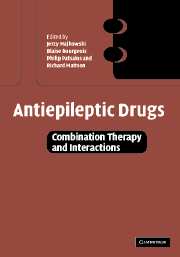Book contents
- Frontmatter
- Contents
- List of contributors
- Foreword
- Foreword
- Acknowledgements
- Part I Introduction
- Part II Pharmacokinetic interactions
- Part III Pharmacodynamic interactions
- Part IV Drug interactions in specific patient populations and special conditions
- 14 Antiepileptic drug interactions in children
- 15 Antiepileptic drug interactions in the elderly
- 16 Antiepileptic drug interactions in pregnancy
- 17 Antiepileptic drug interactions in handicapped and mentally retarded patients
- 18 Antiepileptic drugs and sex steroids
- 19 Antiepileptic drug interactions in patients requiring psychiatric drug treatment
- 20 Antiepileptic drugs in non-epileptic health conditions: possible interactions
- 21 Drug monitoring in combination therapy
- 22 Cognitive side-effects due to antiepileptic drug combinations and interactions
- Part V Conclusions and future perspectives
- Index
20 - Antiepileptic drugs in non-epileptic health conditions: possible interactions
from Part IV - Drug interactions in specific patient populations and special conditions
Published online by Cambridge University Press: 07 September 2009
- Frontmatter
- Contents
- List of contributors
- Foreword
- Foreword
- Acknowledgements
- Part I Introduction
- Part II Pharmacokinetic interactions
- Part III Pharmacodynamic interactions
- Part IV Drug interactions in specific patient populations and special conditions
- 14 Antiepileptic drug interactions in children
- 15 Antiepileptic drug interactions in the elderly
- 16 Antiepileptic drug interactions in pregnancy
- 17 Antiepileptic drug interactions in handicapped and mentally retarded patients
- 18 Antiepileptic drugs and sex steroids
- 19 Antiepileptic drug interactions in patients requiring psychiatric drug treatment
- 20 Antiepileptic drugs in non-epileptic health conditions: possible interactions
- 21 Drug monitoring in combination therapy
- 22 Cognitive side-effects due to antiepileptic drug combinations and interactions
- Part V Conclusions and future perspectives
- Index
Summary
Introduction: AEDs in non-epileptic conditions
Ever since they first appeared, antiepileptic drugs (AEDs) have not infrequently been used to treat patients with conditions other than epilepsy. Some AEDs, e.g. phenytoin (PHT), carbamazepine (CBZ) and valproic acid (VPA), have for long been indicated in a number of neurological and psychiatric disorders. The same is true for some of the new generation AEDs, such as gabapentin (GBP), lamotrigine (LTG), levetiracetam (LEV), oxcarbazepine (O-CBZ), tiagabine (TGB), topiramate (TPM) and pregabalin (PGB). It seems that newer AEDs – compared with the older ones – may be at least equally effective in non-epileptic disorders, but with fewer adverse events, and with minimal or no drug interactions. However, it should be stressed that evidence-based medicine varies broadly as far as the efficacy of particular drugs in given disorders or health conditions is concerned. Moreover, the number of reports and trials, and the extent of usage of these drugs vary greatly.
Epilepsy with its prevalence of about 1% is one of the most common neurological conditions. However, because AEDs have been used in several other neurological and psychiatric conditions with a higher prevalence than epilepsy, altogether they present a large market for AED usage. For example, in the United States LTG, TPM and GBP use – in terms of pharmaceutical market (IMS, 2000, 2001, 2002) – is greater for non-epileptic disorders than for epilepsy; moreover, there is an increasing trend for use of TPM and LTG from 2000 to 2002 (Table 20.1).
Keywords
- Type
- Chapter
- Information
- Antiepileptic DrugsCombination Therapy and Interactions, pp. 369 - 391Publisher: Cambridge University PressPrint publication year: 2005
- 1
- Cited by

